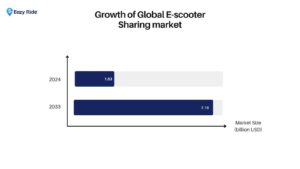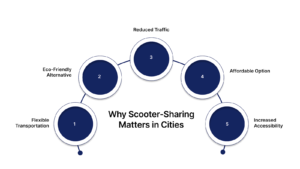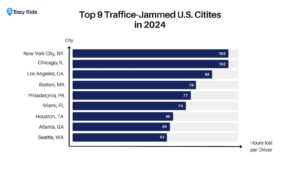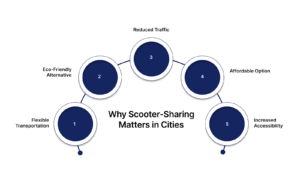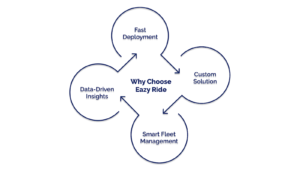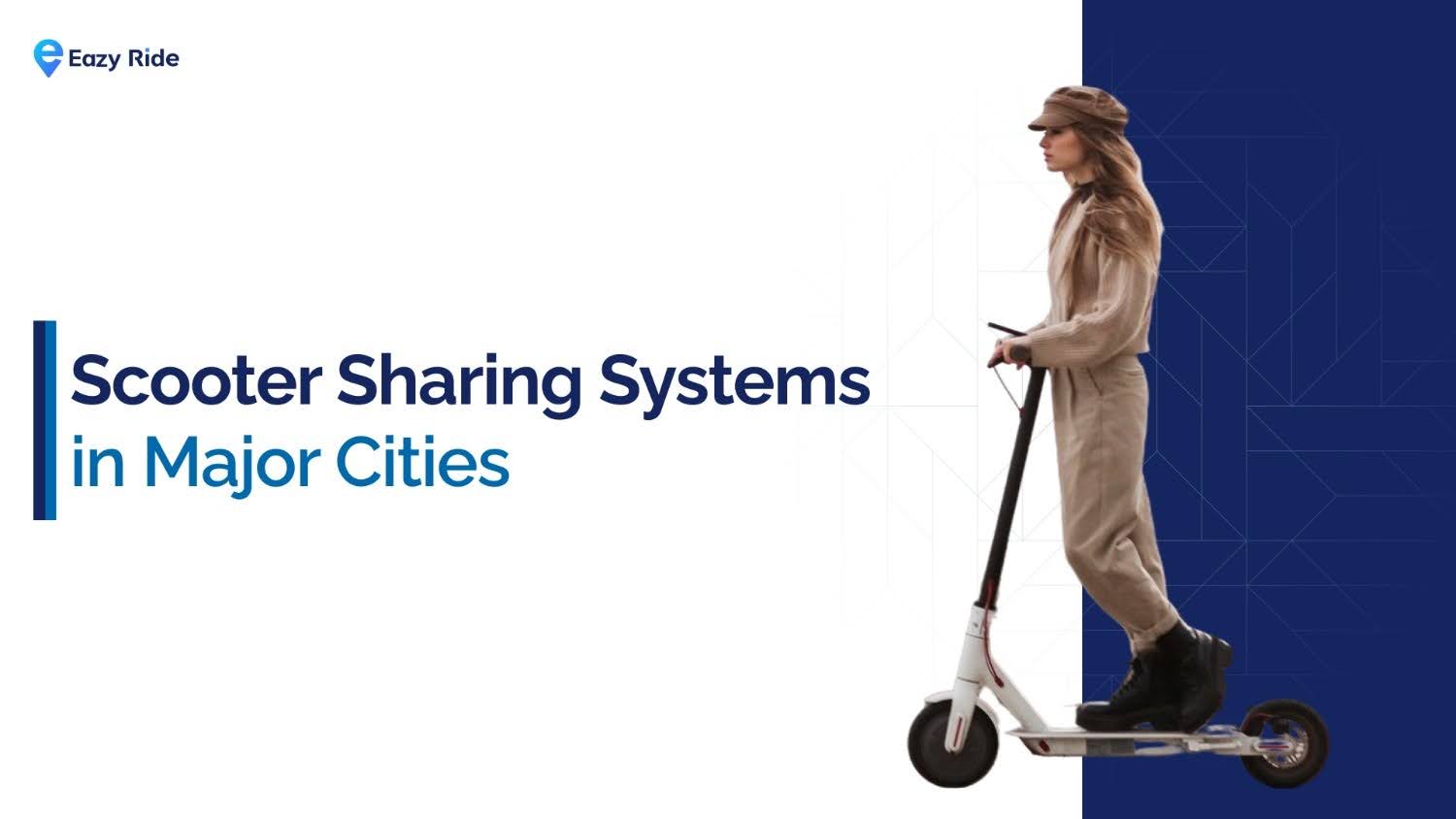 AllAnalytics and research
AllAnalytics and research
Understanding Scooter Sharing Systems in Major Cities
You’ve likely noticed more scooters zipping through your streets and for good reason. Scooter-sharing has become a go-to choice for fast, affordable, and eco-friendly urban travel. The numbers prove it: the global e-scooter sharing market hit $1.53 billion in 2024 and is projected to reach USD 7.10 billion by 2033, growing at 18.56% per year. (see the graph below for a closer look)
This boom means opportunity, but are you prepared for the challenges? Managing a scooter fleet isn’t just about putting vehicles on the road—it’s about solving real-world problems like maintenance, demand fluctuations, and ever-changing regulations.
In this blog, we’ll show you how leading cities run their scooter-sharing systems and give you actionable strategies to keep your fleet running smoothly while delighting riders. Ready to optimize your operations? Let’s dive in.
What is a Scooter-Sharing System?
A scooter-sharing system is a service that allows users to rent electric scooters on demand through a mobile app. These systems are designed to provide a convenient and affordable transportation option for short trips within urban areas.
Example: In a busy downtown area, a user might open a scooter-sharing app, locate a nearby scooter, unlock it, ride it to a coffee shop, and then leave it in a designated parking zone for the next person to use.
The key components of a scooter-sharing system include:
- Electric Scooters: These are typically compact, battery-powered scooters designed for urban commuting. They come with essential features like handlebars, footrests, and brake systems for easy navigation.
- Mobile App: The app enables users to locate available scooters, unlock them, and track their ride. It also provides real-time availability and scooter condition updates.
- Management Software: This software allows fleet owners to track scooter locations, monitor usage, and schedule maintenance. It is crucial in optimizing fleet operations and ensuring that scooters are efficiently distributed and adequately maintained.
- Parking System: A designated parking system ensures that scooters are parked in approved areas, reducing clutter and keeping public spaces clear, ensuring smooth flow of operations.
Scooter-sharing services are particularly popular in densely populated cities, where they help reduce traffic congestion and provide an eco-friendly alternative to driving.
Why are Scooter-Sharing Systems Important in Major Cities?
Scooter-sharing systems are increasingly becoming a key part of urban transportation, offering practical solutions to everyday city challenges. Here’s how they’re making a difference:
- Flexible Transportation: E-scooters provide a fast and easy way to get around, especially for short trips that might not be worth taking a car or bus. Available 24/7, they offer an on-demand option for moving around the city without the need for planning or waiting.
- Eco-Friendly Alternative: As electric vehicles, E-scooters emit no pollution, offering a cleaner alternative to cars. or motorcycles. By reducing the number of gas-powered vehicles on the road, they help cut down on air pollution and contribute to a cleaner urban environment.
- Reduced Traffic: With more people opting for scooters instead of cars, there are fewer vehicles on the road. This can help reduce traffic jams, making commutes quicker and easing pressure on public transportation systems.
- Affordable Option: Renting a scooter is often cheaper than owning a car or relying on taxis or ride-sharing services. With scooter-sharing, you only pay for the time you use, offering a more affordable and flexible way to get around without the costs of ownership.
- Increased Accessibility: Scooter-sharing systems offer a convenient transportation option for people in areas with limited public transit. They also provide a choice for those who don’t have access to a car or prefer not to drive, giving them more mobility and independence.
In short, scooter-sharing systems are becoming an essential part of urban mobility, providing a convenient, affordable, and eco-friendly solution to the challenges of modern city life.
How Does the Scooter-Sharing System Work in Major Cities?
For fleet owners, managing a scooter-sharing system involves more than just offering scooters for rent. It’s about creating a seamless process where technology, logistics, and customer experience work together efficiently. Here’s how scooter-sharing systems typically function:
1. Integrating Scooters into the System
The first and most crucial step is integrating the scooters into the system. This involves connecting each scooter’s IoT device to the app, which allows fleet owners to track and manage the scooters. Skilled developers ensure that the scooters, software, and the user app work together, enabling smooth operation and real-time data exchange.
From here, the scooters are listed in the app, making them available for users to find and rent in real time.
2. User Registration and Setup
Once the scooters are integrated into the system, users can download the app and sign up easily. During the registration process, they enter their personal details and link a payment method. This one-time setup ensures that users can easily rent scooters whenever they need them.
From here, users can instantly access the available scooters in their area and begin their ride.
3. Finding and Unlocking a Scooter
When users are ready to start their ride, they open the app to see a map of available scooters nearby. The app uses GPS to display scooters that are in the vicinity, allowing users to choose one based on its location and battery level.
From here, the user unlocks the scooter by scanning a QR code or using Bluetooth technology through the app. This unlocks the scooter, and the app starts tracking the ride.
4. Riding the Scooter
Once the scooter is unlocked, users can begin their ride. Scooters are designed for easy handling, with features like handlebars, brakes, and footrests for comfort and control. The app continues to monitor the ride, keeping track of the time or distance traveled, and ensures that users adhere to speed limits and route guidelines for safety.
From here, users can travel to their destination, and the app provides real-time monitoring of their journey.
5. Ending the Ride and Parking
After reaching their destination, users need to park the scooter in an appropriate location. Many systems encourage users to park in designated zones to prevent obstruction and ensure that the scooters are available for the next rider.
From here, users end the ride in the app, which locks the scooter and processes the payment. The app may also offer guidance on where to park the scooter to keep the area organized and comply with local rules.
6. Payment Processing
After the ride is completed, the app calculates the cost based on factors like time or distance. Payment is processed through the user’s linked account. Most systems offer quick and secure payment options, allowing users to complete their transactions seamlessly.
From here, the payment is processed, and the scooter is made available for the next rider.
7. Scooter Maintenance and Recharging
After a ride, each scooter needs to be checked for damage and recharged to ensure it’s ready for future use. Some systems have dedicated maintenance teams, while others may rely on independent contractors (often called “chargers”) to collect scooters, recharge them, and bring them back to designated locations.
From here, scooters are either picked up for recharging or repairs, ensuring they are properly maintained and ready for the next user.
8. Fleet Rebalancing and Demand Management
Managing a fleet efficiently also involves rebalancing scooters based on real-time demand. Fleet owners use data from the app to track where scooters are being used most frequently. If certain areas are running low on scooters while others have an oversupply, scooters are relocated to meet demand.
From here, fleet owners can optimize the scooter distribution, ensuring that scooters are available where users need them most and helping improve overall service efficiency.
Scooter-sharing systems offer a flexible and convenient mode of transport for city residents. But behind the scenes, there’s a lot of coordination and technology involved in keeping everything running smoothly.
From the integration of scooters into the system to managing fleet operations, these systems provide a valuable solution for both fleet owners and urban commuters.
Did you know?
On average, drivers in the U.S. cities lose 79 hours every year stuck in traffic, which is more than 3 full days wasted just waiting on the road! This lost time adds up to significant costs in fuel, stress, and productivity, highlighting the urgent need for smarter urban transportation solutions.
Addressing Key Hurdles in Scooter-Sharing Systems
Managing a scooter-sharing fleet in a busy city comes with its share of challenges. From keeping the scooters running smoothly to ensuring they’re available when needed, fleet owners have a lot to juggle. Here’s a closer look at the key challenges and some practical solutions to tackle them:
1. Maintenance and Repairs
Scooters get a lot of use on city streets, and with that comes wear and tear. Breakdowns and mechanical issues can happen, leaving scooters out of service and users frustrated.
Solution: Regular check-ups and a maintenance schedule can go a long way in keeping your fleet running. Keep an eye on things like battery life, tire wear, and brakes. Partnering with local repair teams or having an in-house crew can help get scooters back in action quickly. Platforms like Eazy Ride also help by allowing users to report issues like vehicle damage or illegal parking directly, giving fleet owners the ability to address problems as they arise and keep the fleet running smoothly.
2. Managing Scooter Availability
There’s nothing worse than needing a scooter and not being able to find one nearby. Or having too many scooters crowding a popular area. Keeping the fleet balanced and available where people need it most can be tricky.
Solution: Data can be your best friend here. By tracking where and when scooters are used most, you can predict demand and place scooters where they’re needed. Real-time monitoring allows for quick adjustments, so your scooters are always ready to go in the busiest spots.
3. Compliance with Rules
Different cities have different rules when it comes to scooter-sharing services. From where scooters can be ridden to where they can be parked, keeping up with regulations can feel like a full-time job.
Solution: Staying informed about local regulations is essential, and one effective way to ensure compliance is by setting up virtual boundaries that control where scooters can be used. This includes defining no-ride zones, slow-speed zones, and designated parking areas. With platforms like Eazy Ride, you can easily create and manage these geofenced areas, ensuring your fleet stays within legal limits while improving the overall rider experience.
4. Operational Effectiveness
Managing a fleet is not easy, especially when it comes to recharging, redistributing, and maintaining scooters. A disorganized system can lead to empty scooters in the wrong places, or worse, broken ones that can’t be used.
Solution: Having the right tools in place can make all the difference. Using a fleet management system that tracks scooter locations and battery levels can help operators move scooters where they’re needed most. Setting up charging hubs or partnering with local businesses can optimize the recharging process, ensuring scooters are always ready for the next rider.
5. User Behavior and Safety
While scooters are a fun and convenient way to get around, not all users follow the rules. Reckless riding or improper parking can lead to accidents, injuries, or even fines.
Solution: A little education goes a long way. Offering in-app safety reminders and clear guidelines can help ensure that riders know how to use scooters properly. Encouraging good behavior through rewards or setting up penalties for violations can also keep things running smoothly. And, of course, ensuring all scooters are in good working condition with proper safety features is key to keeping everyone safe.
By addressing these challenges with practical and straightforward solutions, fleet owners can keep their scooter-sharing services running smoothly, providing a better experience for riders and making the system more efficient overall.
Best Practices for Managing a Scooter Fleet in Major Cities
Running a successful scooter-sharing business involves more than just offering a convenient transportation service. Here are some practical tips to help you optimize your fleet operations and increase profitability:
- Diversify Your Fleet: Diversify your fleet by adding a mix of e-scooters, e-bikes, and other micro-mobility solutions. This allows you to serve a variety of riders and locations, improving service flexibility and coverage.
- Update Your App: Regularly update your app to keep it user-friendly and functional. Introduce promotions or loyalty programs to encourage repeat business and improve the overall user experience.
- Use a Management Software: Consider using a comprehensive fleet management platform such as Eazy Ride, which combines rider apps, an admin dashboard, and a fleet operations app in one platform. This solution can be adapted to suit your brand giving you more control over operations and improving fleet management efficiency.
- Utilize Data Analytics: Use data analytics to track usage patterns and forecast demand. This will help you position scooters in high-demand areas, boosting usage and increasing revenue potential.
- Reward Responsible Riding: Implement creative incentives for responsible users, such as rewards for parking in designated areas or for reporting damaged scooters. Encourage eco-friendly riding behavior with discounts or loyalty points.
By adopting these practices optimize their operations, provide a better experience for users, and maximize profitability in the competitive scooter-sharing market.
Ready to Optimize Your Scooter-Sharing Fleet and Lead Urban Mobility?
If you’re passionate about growing your e-roller sharing business but find fleet management and regulatory challenges overwhelming, Eazy Ride is here to simplify everything. Our integrated platform combines rider apps, fleet tracking, and management tools so you can focus on scaling your business and delighting riders.
Why Choose Eazy Ride for Your Scooter Sharing Business?
- Quick Launch & Easy Setup: Get your fleet live in as little as 2 weeks with our ready-to-use, customizable platform.
- Complete White-Label Solution: Offer a seamless experience with your own branded rider app, admin dashboard, and operations app.
- Smart Fleet Management: Real-time tracking, geofencing, and automated maintenance alerts keep your scooters on the road and compliant.
- Data-Driven Insights: Use powerful analytics to optimize scooter distribution, predict demand, and boost profitability.
Don’t get bogged down by operational hassles or tech headaches. Let Eazy Ride handle the complex backend so you can lead the future of urban micro-mobility.
Concluding Thoughts
Running a scooter-sharing fleet can be challenging, but with the right approach, it can also be incredibly rewarding. By staying focused on keeping your scooters in good condition, understanding your users’ needs, and using the right tools to manage everything efficiently, you can ensure your business runs smoothly.
As the scooter-sharing market grows, being adaptable and responsive to changes will help you stay sailing. Ultimately, it’s about providing a reliable, easy experience for your users while keeping things simple and efficient on the operational side.
Looking for a better way to manage your scooter fleet? Eazy Ride offers an all-in-one platform for rider apps and fleet management, with robust features like real-time vehicle tracking and geofencing. Improve your operations and boost customer satisfaction with ease.
Get in touch today to see how Eazy Ride can redefine your fleet management and drive your business forward.
FAQs
1. Can an e-scooter sharing business be profitable?
Absolutely! Profitability comes down to smart operations – keeping your fleet well-maintained, strategically distributed, and aligned with local demand. Focus on efficient management, and the numbers will follow.
2. What does it take to launch a scooter-sharing service?
You’ll need reliable vehicles, a user-friendly app, and the proper city permits. Many operators save time and resources by partnering with established platform providers rather than building tech from scratch.
3. How do I get my city to approve my scooter business?
Start by understanding local micromobility regulations. Cities typically want to see safety plans, proper insurance, and systems to prevent sidewalk clutter. Building good relationships with transportation officials goes a long way.
4. What are the biggest challenges I should prepare for?
Stay ahead of regulatory changes and protect your fleet from misuse. Implementing geofencing technology and clear user guidelines will help you maintain service quality while keeping cities happy.


